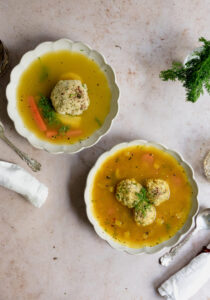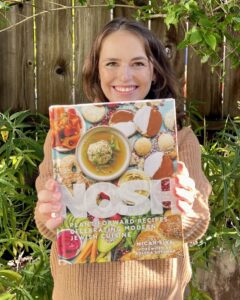I first had the idea to stop eating meat when I was around 12 years old. Like many, I was plagued by “stomach troubles” and generally feeling unwell. I would complain about my stomach woes, but no one seemed to have an answer or silver bullet to cure what ailed me. After months upon months of trial and error (more error than anything), I decided I wanted to try removing meat from my diet.
Naturally, my Jewish mother was shocked and confused, “but what about chicken soup? Brisket?”. While she didn’t fully understand the why, she knew that she could control the how, and we hired my past Hebrew-school-teacher-turned-dietitian to teach us how to eat vegetarian meals as a family.
At that time, our options were largely tofu and canned beans, there were no plant-based chicken or beef in our grocery stores, and don’t get me started on vegan cheese! Thus, the rise in plant-based eating and available products have been so exciting to witness!
My mom was adamant that she would not make multiple dinners every night, I started to cook dinner for the family at a young age, getting a taste of independence in the kitchen. While I wasn’t a particularly skilled cook, I was able to get creative in the kitchen, using what we had, trying new recipes, and trying to make a meal that would please everyone in the family. I had always grown up cooking with my grandmother in the kitchen, so navigating a hot stove or oven was not a foreign concept, and I quickly learned that I felt most at home in the kitchen, donning a homemade apron and sharing food with loved ones.
As I got older, I would make elaborate dinners for my friends, everyone’s birthday and celebration cake, trying new ingredients, recipes, and cuisines as I moved through high school. While I always provided a dish to family gatherings and holidays, there was a part of me that missed the memories that came along with the dishes of my childhood, the stories (and fights) over brisket, and a warm bowl of chicken soup… as I was often left with side dishes or tofu that I brought over myself. I would watch my family slurp up chicken soup, wishing for a vegetable dish that we could enjoy together. It was hard not to feel a little left out.
When my husband and I moved to the UK in 2018, my grandmother passed right before Rosh Hashanah. I couldn’t get home to Canada in time for the burial, so I grieved from afar, making a vegetarian version of her beloved kreplach, a dish that she made every High Holiday season. I rolled, stuffed, and folded dozens of potato kreplach, and with each one, I thought of cooking together in her cozy kitchen, sharing stories of generations past, and the recipes that they would share.
This was a turning point in my life, I knew that I yearned for connection to my Judaism, and I felt most connected to the food… but I ate so differently than my grandparents did. I started to dive into the world of vegetarian food, making vegetarian (and vegan!) matzo ball soups, tzimmes, and kugel; and found beautiful overlap between Judaism and vegetarianism, and room to experiment and conceptualize. By reinventing the memories and dishes I dreamed of, I learned that Jewish food can be vegetarian and you don’t have to choose one over the other.

Recipe: Vegan Matzo balls
Makes: 10 to 12 matzo balls
On the table in… 6 hours, including at least 4 hours 15 minutes resting time.
If you thought eating foods that are traditionally made with eggs was off the table, think again! These matzo balls are made with ground flax, baking powder, chickpea liquid (aquafaba), and chickpea flour to replace the fat, lift, and binding properties of eggs. Inspired by gondi, a Persian chickpea dumpling soup, this recipe for vegan matzo balls is anything but ordinary. While not suitable for those who avoid kitniyot during Passover, these matzo balls can be enjoyed year-round.
Ingredients
1 cup matzo meal
2 tablespoons chickpea flour
1 tablespoon ground flax seeds
1 tablespoon baking powder, kosher for Passover
1 teaspoon salt
1 teaspoon garlic powder
1⁄2 teaspoon black pepper
1⁄2 teaspoon onion powder
1⁄4 cup extra-virgin olive oil
1⁄2 cup liquid from canned chickpeas or white beans (aquafaba) 1⁄3 cup seltzer water
3 tablespoons chopped fresh dill
Directions
In a medium bowl, whisk together the matzo meal, chickpea flour, flax seeds, baking powder, salt, garlic powder, black pepper, and onion
powder.
Add the olive oil, aquafaba, seltzer, and dill and stir until just combined. Cover with plastic wrap and refrigerate for at least 4 hours, or up to overnight.
When ready to cook, roll 1 heaping tablespoon of the mixture into a ball, approximately the size of a golf ball, and place on a plate. Repeat with the rest of the mixture. Cover with plastic wrap and return to the fridge for 15 minutes.
Generously grease a steamer basket with oil. Set the steamer basket fitted with a lid in a large pot of water, place over medium-high heat, and bring to a boil. Once the water is boiling, decrease the heat to medium-low and add the matzo balls to the basket.
Note: They will not expand very much, so they can be placed close to one another.
Cover with the lid and steam for 25 minutes. Carefully remove the matzo balls from the steamer basket using a spatula.
Add the matzo balls to soup when ready to eat.
Meet Our Guest Author
Micah Siva (she/her) is a Jewish, Canadian-born Registered Dietitian and chef living in Northern California, specializing in recipe writing, food photography, and storytelling through food.

You can now purchase her new cookbook Nosh: Plant-Forward Recipes Celebrating Modern Jewish Cuisine.